#E recommended variable
Explore tagged Tumblr posts
Text
That feeling when you have the urge to make a humanized version of a recommended character that nobody cares about


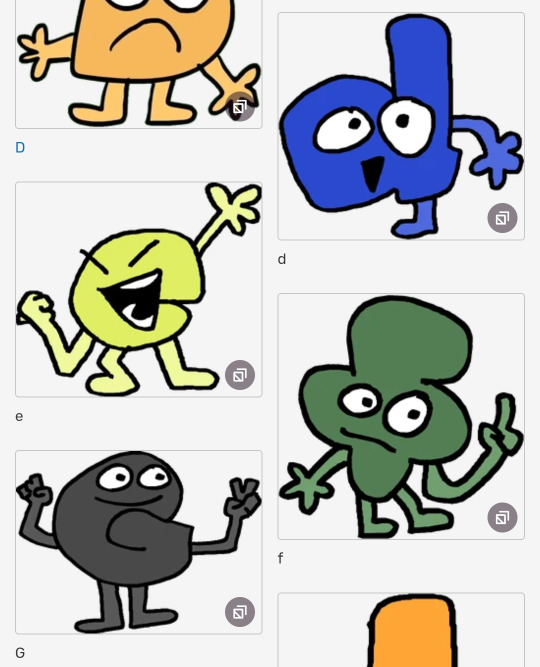
They're a Eurasian Lynx
#bfdi#bfdi tpot#bfb#xfohv#algebralien art#algebralien#e variable#E variable#e#E#e algebralien#E algebralien#e recommended character#E recommended character#e recommended variable#E recommended variable#gijinka#humanized#lynx#eurasian lynx#my art#artists on tumblr#digital art#e gijinka#E gijinka#e humanized#E humanized#bfdi e#bfdi e variable#variable
25 notes
·
View notes
Text
COD Characters as Different Military Aircrafts
———
Soap -> A-10 Thunderbolt: Known for its loud and heavy gatling gun, outstanding close air support and its durability against damage. Its fierce and accurate air defense marks it as one of the best support aircrafts to exist.

Ghost -> B-2 Spirit: Advanced stealth tactics and its ability to easily evade enemy detection to reign down its deadly force makes this bomber, a ghost in the sky.

Roach -> F-14 Tomcat: Despite its air superiority and esteemed long range capabilities, the uncommon design of its “variable-sweep wings” marks it as the most distinctive and intriguing aspect of the aircraft.

Gaz -> AH-64 Apache: Designed for high survivability and equipped with advanced technological targeting components makes it one of the best air support aircrafts in active service.

Price -> P-51 Mustang: An oldie but a goodie; was the star of the show in its prime with its outstanding range of speed, maneuverability, durability, and it’s skill to adapt quickly to different conditions.

Laswell -> E-3 Sentry: Designated for surveillance, communications, and command; it’s your eyes in the sky.

Rudy -> KC-135 Stratotanker: You can always count on this aerial refueling tanker. When in need of support when you’re down, it’s got your back, always loyal to its allies.

Alejandro -> F-15 Eagle: Was built for extreme power, resilience, agility, and to display its aggressive dog-fighting capabilities proving it better than the feared oppositions. Never lost a fight protecting what it stood for.

Valeria -> F-22 Raptor: This jet’s extreme capability to fly nearly completely invisible through radars makes it dangerous in its attacks. The state of the art technological advances allows it to fool anyone who comes across, creating a perfect chance to strike and claim victory.

Graves -> V-22 Osprey: Although its dodgy components can wear the reliability of this aircraft thin, it’s service is still exceptional.

———
If you want a part 2, recommend some characters below for me to do next @_@
#john soap mactavish#simon ghost riley#gary roach sanderson#kyle gaz garrick#john price#kate laswell#rodolfo parra#alejandro vargas#valeria garza#phillip graves#mw2#cod mw2#call of duty#cod characters#modern warfare#og mw2#military#military aircraft#a 10 warthog#b 2 spirit#f 14 tomcat#p 51 mustang#e 3 sentry#kc 135 stratotanker#ah 64 apache#f 15 eagle#f 22 raptor#v 22 osprey#ghost cod#soap mactavish
62 notes
·
View notes
Text
HORROR WEEK- FOTD #144 : apple bolete! (exsudoporus frostii)
the apple bolete (also frost's bolete) is a mycorrhizal fungus in the family boletaceae >:-) it typically grows near the hardwood trees of the eastern US, southern mexico & costa rica. it was chosen for horror week due to its appearance being reminiscent of muscle tissue !!
the big question : will it kill me?? nope !! however, although they are edible, they are not recommended for consumption as it is quite easy to confuse them with other red boletes. ^^


e. frostii description :
"the shape of the cap of the young fruit body ranges from a half sphere to convex, later becoming broadly convex to flat or shallowly depressed, with a diameter of 5–15 cm (2.0–5.9 in). the edge of the cap is curved inward, although as it ages it can uncurl and turn upward. in moist conditions, the cap surface is sticky as a result of its cuticle, which is made of gelatinized hyphae. if the fruit body has dried out after a rain, the cap is especially shiny, sometimes appearing finely areolate (having a pattern of block-like areas similar to cracked, dried mud). young mushrooms have a whitish bloom on the cap surface.
the colour is bright red initially, but fades with age. the flesh is up to 2.5 cm (1.0 in) thick, & ranges in colour from pallid to pale yellow to lemon yellow. the flesh has a variable staining reaction in response to bruising, so some specimens may turn deep blue almost immediately, while others turn blue weakly & slowly.
the tubes comprising the pore surface (the hymenium) are 9–15 mm deep, yellow to olivaceous yellow (mustard yellow), turning dingy blue when bruised. the pores are small (2 to 3 per mm), circular, & until old age a deep red colour that eventually becomes paler. the pore surface is often beaded with yellowish droplets when young (a distinguishing characteristic), & readily stains blue when bruised. the stipe is 4 to 12 cm (1.6 to 4.7 in) long, & 1 to 2.5 cm (0.4 to 1.0 in) thick at its apex. it is roughly equal in thickness throughout its length, though it may taper somewhat toward the top ; some specimens may appear ventricose (swollen in the middle). the stipe surface is mostly red, or yellowish near the base ; it is reticulate — characterized by ridges arranged in the form of a net-like pattern."
[images : source & source] [fungus description : source]
#• fungus of the day !! •#• horror week >:-) •#[exsudoporus frostii]#: frost's bolete :#: apple bolete :#144#||#image undescribed#fungi#undescribed#mushroom#mushrooms#earth#nature#cottagecore#fungus#foraging#forestcore#mycology#fotd#fungus of the day#exsudoporus frostii#frost's bolete#apple bolete#bolete
242 notes
·
View notes
Text


The buildings of Hinrich and Inken Baller are unique if not eccentric contributions to postwar architecture in Berlin: the architect couple pushed the boundaries of social housing regulations in order to maximize space, light, variability and ultimately living comfort. The Ballers, both part of the 68-generation, were opposed to the contemporary social housing and its boxed uniformity that left no room for development. Consequently, they came up with unusual solutions and integrated communal spaces. Their expressive apartment buildings often seem to have grown towards sun and light, elements that were at the core of the architects’ concept that has been treasured by residents ever since. But professional circles e were less enthusiastic about their unconventional solutions and treated the Ballers as outcasts of the architectural establishment. This notwithstanding they were frequently commissioned to build by empathic and venturous clients.
In 2022 the Deutsches Architektur Centrum in Berlin showed „Visiting. Inken Baller und Hinrich Baller, Berlin 1966-89“, a retrospective exhibition of the Ballers’ impressive work curated by Urban Fragment Observatory. The exhibition was accompanied by an eponymous catalogue that has recently been published in a second edition by Park Books.
In keeping with its title, the editors visited Inken & Hinrich Baller for a long interview as well as residents of their buildings. The result is a lively recollection of the architectural climate of West-Berlin, free spirited architects with strong convictions and generally happy residents. The latter emphasize the unusually high living comfort that results from the flowing sequence of rooms and the large balconies.
Beyond these insights it is especially the complete and detailed work catalogue that makes the book indispensable: it includes explanatory texts, all relevant data on the projects, plans as well as old and current photographs that provide detailed insights into the buildings and the lives going on behind their walls. Hence, „Visiting Hinrich & Inken Baller“ is a pivotal publication on the architects, rich and lively just like their architecture. Warmly recommended!
#inken baller#hinrich baller#monograph#architecture#germany#organic architecture#architecture book#park books#book
11 notes
·
View notes
Text
Ten people i’d like to know better!
Tagged by the inimitable @gjdraws <3
last song: ooh. probably my alarm this morning, so imagine dragon's radioactive
favourite colour: yes ? it's as variable as michigan weather tbh. love a good rich deep blue. love a nice green. love a scarlet-y red. love a royal purple. if it looks like i could either dive into it or like it would have a great mouthfeel, i probably love it
last book: still working my way through alfred e. young's masquerade (and i recommend it), but i also just checked out jason schreier's blood, sweat, and pixels on libby for a discord book club (we'll see if i actually get through it, we know how i am)
last movie: prrrrrobably you've got mail for like the third time this year, and that was like last week
last tv show: the residence on netflix. a really fun whodunit with a great cast - highly recommend if you love the way holmesian mysteries unfold
sweet/spicy/savoury: yes please. with the spice, just bear in mind that i'm white. i like spicy stuff and i'll eat a few notches above my actual tolerance because i'm a glutton for punishment, but alas, still white.
last thing i googled : [grumbles] the fuckin...vulkan driver...gpu bullshit...fuckin...dammit
current obsession: okay. listen. it was this 🤏 close to being indiana jones. i could feel it. i was primed. i was ready. but the GODDAMN RAYTRACING DRIVERS --
looking forward to: SPRING? PLEASE?? excited for a few movies coming out this year (the obvious (superman, karate kid legends) and the sleeper (the life of chuck) and THE ONE I DIDN'T KNOW ABOUT (THE CONJURING 4?????), among others). excited for any time i get to spend with friends! uhhhh. i feel like i'm forgetting something but yeah.
tagging (with no pressure and my apologies if you've been tagged already)! @youandthemountains @macchiatosdumptruck @amgeforns @rosie-tyler @crimsonblackrose @phoomwhoosh @an-sceal @landofalwayswinter @carltonlassie @beck-a-leck
#currently floating aimlessly between obsessions but about due to land on something#so that's something for y'all to look forward to and brace yourselves for.#thank you for the taaaaag mwah mwah mwah
11 notes
·
View notes
Text
Balatro-Inspired Spinning Card Tweetcart Breakdown
I recently made a tweetcart of a spinning playing card inspired by finally playing Balatro, the poker roguelike everybody is talking about.
If you don't know what a tweetcart is, it's a type of size-coding where people write programs for the Pico-8 fantasy console where the source code is 280 characters of less, the length of a tweet.
I'm actually not on twitter any more, but I still like 280 characters as a limitation. I posted it on my mastodon and my tumblr.
Here's the tweetcart I'm writing about today:

And here is the full 279 byte source code for this animation:
a=abs::_::cls()e=t()for r=0,46do for p=0,1,.025do j=sin(e)*20k=cos(e)*5f=1-p h=a(17-p*34)v=a(23-r)c=1+min(23-v,17-h)%5/3\1*6u=(r-1)/80z=a(p-.2)if(e%1<.5)c=a(r-5)<5and z<u+.03and(r==5or z>u)and 8or 8-sgn(h+v-9)/2 g=r+39pset((64+j)*p+(64-j)*f,(g+k)*p+(g-k)*f,c)end end flip()goto _
This post is available with much nicer formatting on the EMMA blog. You can read it here.
You can copy/paste that code into a blank Pico-8 file to try it yourself. I wrote it on Pico-8 version 0.2.6b.
I'm very pleased with this cart! From a strictly technical perspective I think it's my favorite that I've ever made. There is quite a bit going on to make the fake 3D as well as the design on the front and back of the card. In this post I'll be making the source code more readable as well as explaining some tools that are useful if you are making your own tweetcarts or just want some tricks for game dev and algorithmic art.
Expanding the Code
Tweetcarts tend to look completely impenetrable, but they are often less complex than they seem. The first thing to do when breaking down a tweetcart (which I highly recommend doing!) is to just add carriage returns after each command.
Removing these line breaks is a classic tweetcart method to save characters. Lua, the language used in Pico-8, often does not need a new line if a command does not end in a letter, so we can just remove them. Great for saving space, bad for readability. Here's that same code with some line breaks, spaces and indentation added:
a=abs ::_:: cls() e=t() for r=0,46 do for p=0,1,.025 do j=sin(e)*20 k=cos(e)*5 f=1-p h=a(17-p*34) v=a(23-r) c=1+min(23-v,17-h)%5/3\1*6 u=(r-1)/80 z=a(p-.2) if(e%1<.5) c= a(r-5) < 5 and z < u+.03 and (r==5 or z>u) and 8 or 8-sgn(h+v-9)/2 g=r+39 pset((64+j)*p+(64-j)*f,(g+k)*p+(g-k)*f,c) end end flip()goto _
Note: the card is 40 pixels wide and 46 pixels tall. Those number will come up a lot. As will 20 (half of 40) and 23 (half of 46).
Full Code with Variables and Comments
Finally, before I get into what each section is doing, here is an annotated version of the same code. In this code, variables have real names and I added comments:
[editor's note. this one came out terribly on tumblr. Please read the post on my other blog to see it]
This may be all you need to get a sense of how I made this animation, but the rest of this post will be looking at how each section of the code contributes to the final effect. Part of why I wanted to write this post is because I was happy with how many different tools I managed to use in such a small space.
flip() goto_
This pattern shows up in nearly every tweetcart:
::_:: MOST OF THE CODE flip()goto _
This has been written about in Pixienop's Tweetcart Basics which I highly recommend for anybody curious about the medium! The quick version is that using goto is shorter than declaring the full draw function that Pico-8 carts usually use.
Two Spinning Points
The card is drawn in rows starting from the top and going to the bottom. Each of these lines is defined by two points that move around a center point in an elliptical orbit.
The center of the top of the card is x=64 (dead center) and y=39 (a sort of arbitrary number that looked nice).
Then I get the distance away from that center that my two points will be using trigonometry.
x_dist = sin(time)*20 y_dist = cos(time)*5
Here are those points:

P1 adds x_dist and y_dist to the center point and P2 subtracts those same values.
Those are just the points for the very top row. The outer for loop is the vertical rows. The center x position will be the same each time, but the y position increases with each row like this: y_pos = row+39
Here's how it looks when I draw every 3rd row going down:
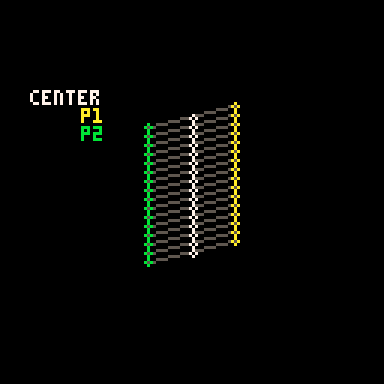
It is worth noting that Pico-8 handles sin() and cos() differently than most languages. Usually the input values for these functions are in radians (0 to two pi), but in Pico-8 it goes from 0 to 1. More info on that here. It takes a little getting used to but it is actually very handy. More info in a minute on why I like values between 0 and 1.
Time
In the shorter code, e is my time variable. I tend to use e for this. In my mind it stands for "elapsed time". In Pico-8 time() returns the current elapsed time in seconds. However, there is a shorter version, t(), which obviously is better for tweetcarts. But because I use the time value a lot, even the 3 characters for t() is often too much, so I store it in the single-letter variable e.
Because it is being used in sine and cosine for this tweetcart, every time e reaches 1, we've reached the end of a cycle. I would have liked to use t()/2 to slow this cart down to be a 2 second animation, but after a lot of fiddling I wound up being one character short. So it goes.
e is used in several places in the code, both to control the angle of the points and to determine which side of the card is facing the camera.
Here you can see how the sine value of e controls the rotation and how we go from showing the front of the card to showing the back when e%1 crosses the threshold of 0.5.
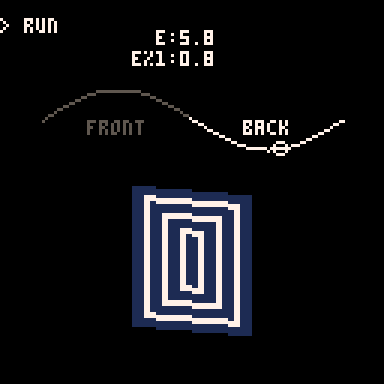
Drawing and Distorting the Lines
Near the top and bottom of the loop we'll find the code that determines the shape of the card and draws the horizontal lines that make up the card. Here is the loop for drawing a single individual line using the code with expanded variable names:
for prc = 0,1,.025 do x_dist = sin(time)*20 y_dist = cos(time)*5 ... y_pos = row+39 pset( (64+x_dist)*prc + (64-x_dist)*(1-prc), (y_pos+y_dist)*prc + (y_pos-y_dist)*(1-prc), color) end
You might notice that I don't use Pico-8's line function! That's because each line is drawn pixel by pixel.
This tweetcart simulates a 3D object by treating each vertical row of the card as a line of pixels. I generate the points on either side of the card(p1 and p2 in this gif), and then interpolate between those two points. That's why the inner for loop creates a percentage from 0 to 1 instead of pixel positions. The entire card is drawn as individual pixels. I draw them in a line, but the color may change with each one, so they each get their own pset() call.
Here's a gif where I slow down this process to give you a peek at how these lines are being drawn every frame. For each row, I draw many pixels moving across the card between the two endpoints in the row.

Here's the loop condition again: for prc = 0,1,.025 do
A step of 0.025 means there are 40 steps (0.025 * 40 = 1.0). That's the exact width of the card! When the card is completely facing the camera head-on, I will need 40 steps to make it across without leaving a gap in the pixels. When the card is skinnier, I'm still drawing all 40 pixels, but many of them will be in the same place. That's fine. The most recently drawn one will take priority.
Getting the actual X and Y position
I said that the position of each pixel is interpolated between the two points, but this line of code may be confusing:
y_pos = row+39 pset( (64+x_dist)*prc + (64-x_dist)*(1-prc), (y_pos+y_dist)*prc + (y_pos-y_dist)*(1-prc), color)
So let's unpack it a little bit. If you've ever used a Lerp() function in something like Unity you've used this sort of math. The idea is that we get two values (P1 and P2 in the above example), and we move between them such that a value of 0.0 gives us P1 and 1.0 gives us P2.
Here's a full cart that breaks down exactly what this math is doing:

::_:: cls() time = t()/8 for row = 0,46 do for prc = 0,1,.025 do x_dist = sin(time)*20 y_dist = cos(time)*5 color = 9 + row % 3 p1x = 64 + x_dist p1y = row+39 + y_dist p2x = 64 - x_dist p2y = row+39 - y_dist x = p2x*prc + p1x*(1-prc) y = p2y*prc + p1y*(1-prc) pset( x, y, color) end end flip()goto _
I'm defining P1 and P2 very explicitly (getting an x and y for both), then I get the actual x and y position that I use by multiplying P2 by prc and P1 by (1-prc) and adding the results together.
This is easiest to understand when prc is 0.5, because then we're just taking an average. In school we learn that to average a set of numbers you add them up and then divide by how many you had. We can think of that as (p1+p2) / 2. This is the same as saying p1*0.5 + p2*0.5.
But the second way of writing it lets us take a weighted average if we want. We could say p1*0.75 + p2*0.25. Now the resulting value will be 75% of p1 and 25% of p2. If you laid the two values out on a number line, the result would be just 25% of the way to p2. As long as the two values being multiplied add up to exactly 1.0 you will get a weighted average between P1 and P2.
I can count on prc being a value between 0 and 1, so the inverse is 1.0 - prc. If prc is 0.8 then 1.0-prc is 0.2. Together they add up to 1!
I use this math everywhere in my work. It's a really easy way to move smoothly between values that might otherwise be tricky to work with.
Compressing
I'm using a little over 400 characters in the above example. But in the real cart, the relevant code inside the loops is this:
j=sin(e)*20 k=cos(e)*5 g=r+39 pset((64+j)*p+(64-j)*f,(g+k)*p+(g-k)*f,c)
which can be further condensed by removing the line breaks:
j=sin(e)*20k=cos(e)*5g=r+39pset((64+j)*p+(64-j)*f,(g+k)*p+(g-k)*f,c)
Because P1, P2 and the resulting interpolated positions x and y are never used again, there is no reason to waste chars by storing them in variables. So all of the interpolation is done in the call to pset().
There are a few parts of the calculation that are used more than once and are four characters or more. Those are stored as variables (j, k & g in this code). These variables tend to have the least helpful names because I usually do them right at the end to save a few chars so they wind up with whatever letters I have not used elsewhere.
Spinning & Drawing
Here's that same example, but with a checker pattern and the card spinning. (Keep in mind, in the real tweetcart the card is fully draw every frame and would not spin mid-draw)
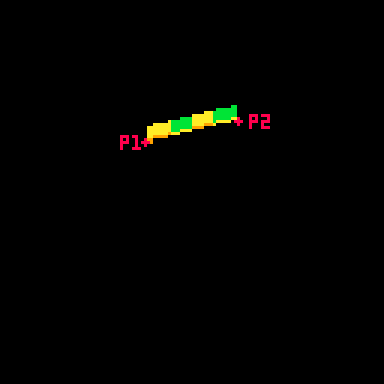
This technique allows me to distort the lines because I can specify two points and draw my lines between them. Great for fake 3D! Kind of annoying for actually drawing shapes, because now instead of using the normal Pico-8 drawing tools, I have to calculate the color I want based on the row (a whole number between0 and 46) and the x-prc (a float between 0 and 1).
Drawing the Back
Here's the code that handles drawing the back of the card:
h=a(17-p*34) v=a(23-r) c=1+min(23-v,17-h)%5/3\1*6
This is inside the nested for loops, so r is the row and p is a percentage of the way across the horizontal line.
c is the color that we will eventually draw in pset().
h and v are the approximate distance from the center of the card. a was previously assigned as a shorthand for abs() so you can think of those lines like this:
h=abs(17-p*34) v=abs(23-r)
v is the vertical distance. The card is 46 pixels tall so taking the absolute value of 23-r will give us the distance from the vertical center of the card. (ex: if r is 25, abs(23-r) = 2. and if r is 21, abs(23-r) still equals 2 )
As you can probably guess, h is the horizontal distance from the center. The card is 40 pixels wide, but I opted to shrink it a bit by multiplying p by 34 and subtracting that from half of 34 (17). The cardback just looks better with these lower values, and the diamond looks fine.
The next line, where I define c, is where things get confusing. It's a long line doing some clunky math. The critical thing is that when this line is done, I need c to equal 1 (dark blue) or 7 (white) on the Pico-8 color pallette.
Here's the whole thing: c=1+min(23-v,17-h)%5/3\1*6
Here is that line broken down into much more discrete steps.
c = 1 --start with a color of 1 low_dist = min(23-v,17-h) --get the lower inverted distance from center val = low_dist % 5 --mod 5 to bring it to a repeating range of 0 to 5 val = val / 3 --divide by 3. value is now 0 to 1.66 val = flr(val) --round it down. value is now 0 or 1 val = val * 6 --multiply by 6. value is now 0 or 6 c += val --add value to c, making it 1 or 7
The first thing I do is c=1. That means the entire rest of the line will either add 0 or 6 (bumping the value up to 7). No other outcome is acceptable. min(23-v,17-h)%5/3\1*6 will always evaluate to 0 or 6.
I only want the lower value of h and v. This is what will give it the nice box shape. If you color the points inside a rectangle so that ones that are closer to the center on their X are one color and ones that are closer to the center on their Y are a different color you'll get a pattern with clean diagonal lines running from the center towards the corners like this:

You might think I would just use min(v,h) instead of the longer min(23-v,17-h) in the actual code. I would love to do that, but it results in a pattern that is cool, but doesn't really look like a card back.

I take the inverted value. Instead of having a v that runs from 0 to 23, I flip it so it runs from 23 to 0. I do the same for h. I take the lower of those two values using min().
Then I use modulo (%) to bring the value to a repeating range of 0 to 5. Then I divide that result by 3 so it is 0 to ~1.66. The exact value doens't matter too much because I am going round it down anyway. What is critical is that it will become 0 or 1 after rounding because then I can multiply it by a specific number without getting any values in between.
Wait? If I'm rounding down, where is flr() in this line: c=1+min(23-v,17-h)%5/3\1*6?
It's not there! That's because there is a sneaky tool in Pico-8. You can use \1 to do the same thing as flr(). This is integer division and it generally saves a 3 characters.
Finally, I multiply the result by 6. If it is 0, we get 0. If it is 1 we get 6. Add it to 1 and we get the color we want!
Here's how it looks with each step in that process turned on or off:
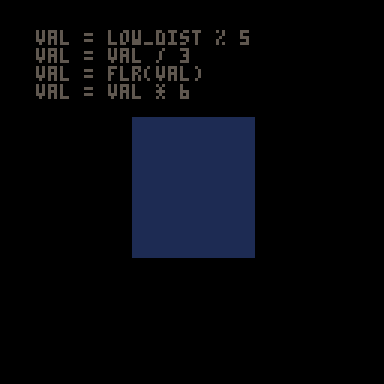
A Note About Parentheses
When I write tweetcarts I would typically start by writing this type of line like this: c=1+ (((min(23-v,17-h)%5)/3) \1) *6
This way I can figure out if my math makes sense by using parentheses to ensure that my order of operations works. But then I just start deleting them willy nilly to see what I can get away with. Sometimes I'm surprised and I'm able to shave off 2 characters by removing a set of parentheses.
The Face Side
The face side with the diamond and the "A" is a little more complex, but basically works the same way as the back. Each pixel needs to either be white (7) or red (8). When the card is on this side, I'll be overwriting the c value that got defined earlier.

Here's the code that does it (with added white space). This uses the h and v values defined earlier as well as the r and p values from the nested loops.
u=(r-1)/80 z=a(p-.2) if(e%1<.5) c= a(r-5) < 5 and z < u+.03 and (r==5 or z>u) and 8 or 8-sgn(h+v-9)/2
Before we piece out what this is doing, we need to talk about the structure for conditional logic in tweetcarts.
The Problem with If Statements
The lone line with the if statement is doing a lot of conditional logic in a very cumbersome way designed to avoid writing out a full if statement.
One of the tricky things with Pico-8 tweetcarts is that the loop and conditional logic of Lua is very character intensive. While most programming language might write an if statement like this:
if (SOMETHING){ CODE }
Lua does it like this:
if SOMETHING then CODE end
Using "then" and "end" instead of brackets means we often want to bend over backwards to avoid them when we're trying to save characters.
Luckily, Lua lets you drop "then" and "end" if there is a single command being executed inside the if.
This means we can write
if(e%1 < 0.5) c=5
instead of
if e%1 < 0.5 then c=5 end
This is a huge savings! To take advantage of this, it is often worth doing something in a slightly (or massively) convoluted way if it means we can reduce it to a single line inside the if. This brings us to:
Lua's Weird Ternary Operator
In most programming language there is an inline syntax to return one of two values based on a conditional. It's called the Ternary Operator and in most languages I use it looks like this:
myVar = a>b ? 5 : 10
The value of myVar will be 5 if a is greater than b. Otherwise is will be 10.
Lua has a ternary operator... sort of. You can read more about it here but it looks something like this:
myVar = a>b and 5 or 10
Frankly, I don't understand why this works, but I can confirm that it does.
In this specific instance, I am essentially using it to put another conditional inside my if statement, but by doing it as a single line ternary operation, I'm keeping the whole thing to a single line and saving precious chars.
The Face Broken Out
The conditional for the diamond and the A is a mess to look at. The weird syntax for the ternary operator doesn't help. Neither does the fact that I took out any parentheses that could make sense of it.
Here is the same code rewritten with a cleaner logic flow.
--check time to see if we're on the front half if e%1 < .5 then --this if checks if we're in the A u=(r-1)/80 z=a(p-.2) if a(r-5) < 5 and z < u+.03 and (r==5 or z>u) then c = 8 --if we're not in the A, set c based on if we're in the diamond else c = 8-sgn(h+v-9)/2 end end
The first thing being checked is the time. As I explained further up, because the input value for sin() in Pico-8 goes from 0 to 1, the midpoint is 0.5. We only draw the front of the card if e%1 is less than 0.5.
After that, we check if this pixel is inside the A on the corner of the card or the diamond. Either way, our color value c gets set to either 7 (white) or 8 (red).
Let's start with diamond because it is easier.
The Diamond
This uses the same h and v values from the back of the card. The reason I chose diamonds for my suit is that they are very easy to calculate if you know the vertical and horizontal distance from a point! In fact, I sometimes use this diamond shape instead of proper circular hit detection in size-coded games.
Let's look at the line: c = 8-sgn(h+v-9)/2
This starts with 8, the red color. Since the only other acceptable color is 7 (white), tha means that sgn(h+v-9)/2 has to evaluate to either 1 or 0.
sgn() returns the sign of a number, meaning -1 if the number is negative or 1 if the number is positive. This is often a convenient way to cut large values down to easy-to-work-with values based on a threshold. That's exactly what I'm doing here!
h+v-9 takes the height from the center plus the horizontal distance from the center and checks if the sum is greater than 9. If it is, sgn(h+v-9) will return 1, otherwise -1. In this formula, 9 is the size of the diamond. A smaller number would result in a smaller diamond since that's the threshold for the distance being used. (note: h+v is NOT the actual distance. It's an approximation that happens to make a nice diamond shape.)
OK, but adding -1 or 1 to 8 gives us 7 or 9 and I need 7 or 8.
That's where /2 comes in. Pico-8 defaults to floating point math, so dividing by 2 will turn my -1 or 1 into -0.5 or 0.5. So this line c = 8-sgn(h+v-9)/2 actually sets c to 7.5 or 8.5. Pico-8 always rounds down when setting colors so a value of 7.5 becomes 7 and 8.5 becomes 8. And now we have white for most of the card, and red in the space inside the diamond!
The A
The A on the top corner of the card was the last thing I added. I finished the spinning card with the card back and the diamond and realized that when I condensed the whole thing, I actually had about 50 characters to spare. Putting a letter on the ace seemed like an obvious choice. I struggled for an evening trying to make it happen before deciding that I just couldn't do it. The next day I took another crack at it and managed to get it in, although a lot of it is pretty ugly! Luckily, in the final version the card is spinning pretty fast and it is harder to notice how lopsided it is.
I mentioned earlier that my method of placing pixels in a line between points is great for deforming planes, but makes a lot of drawing harder. Here's a great example. Instead of just being able to call print("a") or even using 3 calls to line() I had to make a convoluted conditional to check if each pixel is "inside" the A and set it to red if it is.
I'll do my best to explain this code, but it was hammered together with a lot of trial and error. I kept messing with it until I found an acceptable balance between how it looked and how many character it ate up.
Here are the relevant bits again:
u=(r-1)/80 z=a(p-.2) if a(r-5) < 5 and z < u+.03 and (r==5 or z>u) then c = 8
The two variables above the if are just values that get used multiple times. Let's give them slightly better names. While I'm making edits, I'll expand a too since that was just a replacement for abs().
slope = (r-1)/80 dist_from_center = abs(p-.2) if abs(r-5) < 5 and dist_from_center < slope+.03 and (r==5 or dist_from_center>slope) then c = 8
Remember that r is the current row and p is the percentage of the way between the two sides where this pixel falls.
u/slope here is basically how far from the center line of the A the legs are at this row. As r increases, so does slope (but at a much smaller rate). The top of the A is very close to the center, the bottom is further out. I'm subtracting 1 so that when r is 0, slope is negative and will not be drawn. Without this, the A starts on the very topmost line of the card and looks bad.
z/dist_from_center is how far this particular p value is from the center of the A (not the center of the card), measured in percentage (not pixels). The center of the A is 20% of the way across the card. This side of the card starts on the right (0% is all the way right, 100% is all the way left), which is why you see the A 20% away from the right side of the card.
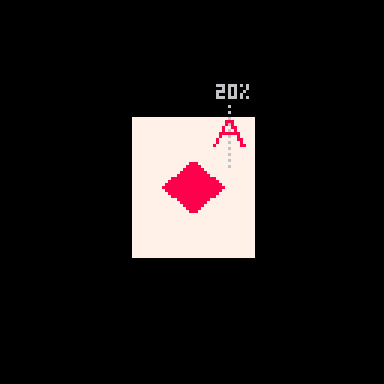
These values are important because the two legs of the A are basically tiny distance checks where the slope for a given r is compared against the dist_from_center. There are 3 checks used to determine if the pixel is part of the A.
if a(r-5) < 5 and z < u+.03 and (r==5 or z>u) then
The first is abs(r-5) < 5. This checks if r is between 1 and 9, the height of my A.
The second is dist_from_center < slope+.03. This is checking if this pixel's x distance from the center of the A is no more than .03 bigger than the current slope value. This is the maximum distance that will be considered "inside" the A. All of this is a percentage, so the center of the A is 0.20 and the slope value will be larger the further down the A we get.
Because I am checking the distance from the center point (the grey line in the image above), this works on either leg of the A. On either side, the pixel can be less than slope+.03 away.
Finally, it checks (r==5 or dist_from_center>slope). If the row is exactly 5, that is the crossbar across the A and should be red. Otherwise, the distance value must be greater than slope (this is the minimum value it can have to be "inside" the A). This also works on both sides thanks to using distance.
Although I am trying to capture 1-pixel-wide lines to draw the shape of the A, I could not think of a cleaner way than doing this bounding check. Ignoring the crossbar on row 5, you can think about the 2nd and 3rd parts of the if statement essentially making sure that dist_from_center fits between slope and a number slightly larger than slope. Something like this:
slope < dist_from_center < slope+0.03
Putting it Together
All of this logic needed to be on a single line to get away with using the short form of the if statement so it got slammed into a single ternary operator. Then I tried removing parentheses one at a time to see what was structurally significant. I wish I could say I was more thoughtful than that but I wasn't. The end result is this beefy line of code:
if(e%1<.5)c=a(r-5)<5and z<u+.03and(r==5or z>u)and 8or 8-sgn(h+v-9)/2
Once we've checked that e (our time value) is in the phase where we show the face, the ternary operator checks if the pixel is inside the A. If it is, c is set to 8 (red). If it isn't, then we set c = 8-sgn(h+v-9)/2, which is the diamond shape described above.
That's It!
Once we've set c the tweetcart uses pset to draw the pixel as described in the section on drawing the lines.
Here's the full code and what it looks like when it runs again. Hopefully now you can pick out more of what's going on!
a=abs::_::cls()e=t()for r=0,46do for p=0,1,.025do j=sin(e)*20k=cos(e)*5f=1-p h=a(17-p*34)v=a(23-r)c=1+min(23-v,17-h)%5/3\1*6u=(r-1)/80z=a(p-.2)if(e%1<.5)c=a(r-5)<5and z<u+.03and(r==5or z>u)and 8or 8-sgn(h+v-9)/2 g=r+39pset((64+j)*p+(64-j)*f,(g+k)*p+(g-k)*f,c)end end flip()goto _

I hope this was helpful! I had a lot of fun writing this cart and it was fun to break it down. Maybe you can shave off the one additional character needed to slow it down by using e=t()/2 a bit. If you do, please drop me a line on my mastodon or tumblr!
And if you want to try your hand at something like this, consider submitting something to TweetTweetJam which just started! You'll get a luxurious 500 characters to work with!
Links and Resources
There are some very useful posts of tools and tricks for getting into tweetcarts. I'm sure I'm missing many but here are a few that I refer to regularly.
Pixienop's tweetcart basics and tweetcart studies are probably the single best thing to read if you want to learn more.
Trasevol_Dog's Doodle Insights are fascinating, and some of them demonstrate very cool tweetcart techniques.
Optimizing Character Count for Tweetcarts by Eli Piilonen / @2DArray
Guide for Making Tweetcarts by PrincessChooChoo
The official documentation for the hidden P8SCII Control Codes is worth a read. It will let you do wild things like play sound using the print() command.
I have released several size-coded Pico-8 games that have links to heavily annotated code:
Pico-Mace
Cold Sun Surf
1k Jump
Hand Cram
And if you want to read more Pico-8 weirdness from me, I wrote a whole post on creating a networked Pico-8 tribute to Frog Chorus.
18 notes
·
View notes
Note
Hey, I have ADD that only just got diagnosed. Pretty sure my 5yo daughter has the exact same style of it. I had trouble listening to people because I legitimately couldn’t focus on what they were saying, and she’s also struggling with it.
For other situations, I’ve taught her the strategies I figured out and taught myself over the years. For the listening… I don’t know how to help. I still struggle with not interrupting people, noticing people are talking to me, etc, and I’m nearly thirty years older than her!
It’s driving my partner bonkers, though. They don’t know how to get her to listen to important information and asked me for help… Do YOU have any advice? I tried googling it and got stuff about discipline that was just…awful.
Side notes: I’m autistic, she might be, too. She’s easily frightened so surprises can make her burst into tears. Not sure if you might need anything else.
Also not sure if you’re still active, but I’m desperate enough to send an ask anyway.
Thanks for your time!
Sent August 3, 2023
My 8yo also has trouble listening. I think it's a pretty normal thing regardless, but of course we ADHDers can struggle more than typical people because our attention is so variable.
What can help with this issue (everyone is different, some might help, some might make things worse):
Fidget toys--sometimes if our hands are busy, our brains can focus better.
Visual aids--use pictures to illustrate your points.
Limit distractions--if there's something that particularly affects her ability to listen, have an expectation that she stop that thing when someone is talking to her. For example, if words are in front of my face I don't hear what people are saying to me: the text shuts down my ears. So I have to ensure that I'm not looking at words if someone is talking to me.
Choose your times carefully--it's normal to struggle more when something is out of whack, and ADHDers aren't great at noticing these things. Don't try to tell her something important if she is hungry, needs to use the bathroom, is too hot or too cold, is really tired or overwhelmed, or is in a heightened emotional state.
Keep age in mind--There are things that are developmentally normal for 5yos, and I think tuning out adults is one of them. The number of interesting moments I've had with neurotypical 5yos (back in my babysitting days) is pretty high.
I would also recommend the book How to Talk so Little Kids Will Listen, by Joanna Faber and Julie King. It's apparently available in print, as an e-book, and as an audio book. I haven't read it myself (I bought it when my kid was little but he's 8 now so I guess I don't need the book anymore) but lots of parents recommend it.
Followers, have you found ways to get yourself to direct your focus to what you actually need to pay attention to?
-J
37 notes
·
View notes
Note
What would you suggest watching/reading first if I wanted to get more into Johnny C, E. Nigma could work too but I'm more interested in Mr. Spook
I hope you know whoever you are anon that you sent me into an actual frenzy by asking me this (in a good way).
So full disclosure: I am a Picky Bitch with interpretations of Johnny Crane. I don't talk about it a lot because hey, part of the joy of these characters is that there are so many variable versions of the same character, but I range from being apathetic to having BEEF with several iterations of him- some of which other people really enjoy. And obviously, that's fine. I'm just saying this for reasons that'll be clear in a bit.
To me personally, I genuinely think one of the best places to start with Crane is the comic Scarecrow: Year One. It's a backstory/villain introduction comic that came out in 2005 that I personally really like to use as the standard for Johnny's backstory, and that I think could give you some interesting insight to who he is as a character/where he comes from as you explore other pieces with him in it (since pieces entirely dedicated to exploring him as a character/his origins and motives aren't exactly super common). He also has an alternate origin story in the New 52 comics (basically anything with him in it labelled New 52) that I... well. Personally I don't like it as much, but it would be remiss of me not to mention it, as it's a key part of his character in that entire reboot. Looking up a list of the issues featuring him could likely give you an insight into that version of him, at least!
If you were interested in older iterations of him history-wise, before he was really... I don't know, sharpened up a bit? Given nastier burdens to bear emotionally and handed a whole new coterie of motives? I would honestly recommend watching the episodes featuring him in the 90s Batman: The Animated Series as a visual choice. There are a whole coterie of older comics that feature him as well, but I wouldn't call all of them a good intro point(?)
There are a lot of really good comics I'd love to recommend, but on that same front: I don't really consider them all a good starting point for the character, I guess- if you want to look at their origins before moving on to see the different directions he's been taken in as a pre-established character. Some of my personal favourites featuring Crane are Kings of Fear, Year One (previously mentioned), this Incredibly specific 2022 comic that was part of Adventures Of The Dark Knight that I am still fighting for my life to identify entirely, Masters of Fear, and bits and pieces of like 17 million other pieces that I've scavenged based on what I love most about his character and how I personally like to view him. People also seem very fond of the Arkham games Crane, although I personally have Largely Mixed Feelings about him. For the sake of length, I'm gonna reblog this with a few Eddie recommendations if you're interested in those as well. I hope this proves helpful to some degree! I can always dig further into a list of reccomendations if you'd like (whoever you are.).
#jesus this got long sorry anon#asks open#asks answered#so happy with how many questions people have asked me recently tbh i love you tumblr#batman rogues#jonathan crane#scarecrow dc
6 notes
·
View notes
Text
Weekly Press Briefing #94
Welcome back to the Weekly Press Briefing, where we bring you highlights from The West Wing fandom each week, including new fics, ongoing challenges, and more! This briefing covers all things posted from April 7 - April 13, 2024. Did we miss something? Let us know; you can find our contact info at the bottom of this briefing!
Challenges/Prompts:
There are no open challenges or events on our radar this week. Do you have a challenge or event you’d like us to promote or know of one we’re missing? Be sure to get in touch with us! Contact info is at the bottom of this briefing.
This Week in Canon:
Welcome back to This Week in Canon, where we revisit moments in The West Wing that occurred on these dates during the show’s run.
Season 7, Episode 17: Election Day Part II aired on April 9, 2006.
Photos/Videos:
Here’s what was posted from April 7 – April 13:
Allison Janney posted screenshots from this week’s Palm Royale episode.
Dule Hill posted about his daughter Kennedy’s partnership with Backlot Coffee.
Dule Hill posted promo about his upcoming PBS arts and travel show, The Express Way, which airs April 23rd at 9/8 central.
Elisabeth Moss posted a promo video for her upcoming FX show, The Veil, which premieres April 30.
Marlee Matlin posted photos from her trip get her 18th tattoo.
Mary McCormack posted a video of herself and John Slattery telling one fighter pilot’s story in honor of National Former Prisoner of War Recognition Day.
Melissa Fitzgerald posted a promo graphic for The 50, a film featured at All Rise’s 2023 conference. It is now available VOD on Apple or Prime.
Donna Moss Daily: April 7 | April 8 | April 9 | April 10 | April 11 | April 12 | April 13
Daily Josh Lyman: April 7 | April 8 | April 9 | April 10 | April 11 | April 12 | April 13
No Context BWhit: April 7 | April 8 | April 9 | April 11 | April 12 | April 13
@twwarchive: April 7 | April 8 | April 9 | April 10 | April 11 | April 13
Editors’ Choice:
No recommendations this week. We'll be back with more stories soon!
Fics:
Presenting your weekly roundup of fics posted in the tag for The West Wing on Archive of Our Own.
Josh/Donna
Self-Evaluation by Telperien | Rated T | Josh Lyman/Donna Moss | In Progress
all i know is a simple name (and everything has changed) by JessBakesCakes for sam_writes_fics | Rated G | Josh Lyman/Donna Moss | Complete
Other Pairings/Gen Fic
Regarding Jamie: Sound and Fury by mlea7675 | Rated G | Helen Santos/Matt Santos | In Progress
An Intriguing Variable by silasfinch for justdreaming88 | Ellie Bartlet/Original Female Character(s) | In Progress
you just got me started by taliamytalia | Rated E | Josh Lyman/Sam Seaborn | Complete
Tuesday, I’m in love. by muldxr for wabadabadaba | Rated T | Joey Lucas/Josh Lyman | Complete
This Seat Taken by Forgott3nQu33n | Rated G | Will Bailey/Kate Harper | Complete
The First Lady by unseenacademic | Rated T | | Abbey Bartlet/Jed Bartlet | In Progress
Multiple Pairings
What Sons Do by kcat1971 | Rated M | Josh Lyman/Donna Moss, Helen Santos/Matt Santos, Abbey Bartlet/Jed Bartlet, Ainsley Hayes/Sam Seaborn, Zoey Bartlet/Charlie Young | In Progress
THE WEEKLY PRESS BRIEFING TEAM CAN BE REACHED VIA THE FOLLOWING METHODS:
Twitter: @TWWPress
Email: [email protected]
Feel free to let us know if we missed something, if you have an event you’d like us to promote, or if you have an item that you’d like included in the next briefing!
xx, What’s next?
#the west wing#tww#tww fandom#tww fic#west wing#josh lyman#donna moss#cj cregg#sam seaborn#toby ziegler#weekly press briefing
5 notes
·
View notes
Text


Chihili is a forward-thinking online custom clothing retailer that has been causing a stir in the market with its state-of-the-art technology and customer-first philosophy. Chihili, which focuses on offering a smooth purchasing experience, has become more well-liked by both customers and companies. We will examine the history, business strategy, and effects Chihili has had on the e-commerce scene as we delve into the numerous facets of this platform.
Background and Histories
A group of IT enthusiasts saw the potential of e-commerce to revolutionize consumer shopping behavior and created Chihili in 2010. The business began as a little online store with a small selection of goods. However, Chihili quickly broadened its business and changed the range of products it offered because to its dedication to innovation and client satisfaction.Company Structure
Chihili differs from conventional e-commerce platforms thanks to its distinctive business strategy. The business uses cutting-edge machine learning and artificial intelligence algorithms to customize each customer's purchasing experience. Chihili makes personalized product recommendations based on user behavior and preferences, which boosts customer happiness and boosts revenue.
Chihili has also built solid relationships with suppliers and manufacturers, which enables them to provide a large selection of goods at affordable costs. Customers gain from this, but small businesses can also take advantage of the chance to reach a wider audience and increase their market presence.
Important attributes and offerings Important attributes and offerings Chihili provides a number of tools and services to improve its customers' overall purchasing experiences. The user-friendly search functionality is one of the best parts, enabling quick and effective product discovery. In order to provide precise and pertinent results, the search algorithm considers a number of variables, including brand, price, and user reviews.

Furthermore, Chihili offers a smooth and safe payment method so that users can transact with confidence. To meet the various demands of its worldwide clientele, the business also provides a range of customizable shipping choices, such as international shipping and expedited delivery.
Chihili provides a number of tools and services to improve its customers' overall purchasing experiences. The user-friendly search functionality is one of the best parts, enabling quick and effective product discovery. In order to provide precise and pertinent results, the search algorithm considers a number of variables, including brand, price, and user reviews.
Furthermore, Chihili offers a smooth and safe payment method so that users can transact with confidence. To meet the various demands of its worldwide clientele, the business also provides a range of customizable shipping choices, such as international shipping and expedited delivery.
Chihili provides a number of tools and services to improve its customers' overall purchasing experiences.Important attributes and offerings
Chihili provides a number of tools and services to improve its customers' overall purchasing experiences. The user-friendly search functionality is one of the best parts, enabling quick and effective product discovery. In order to provide precise and pertinent results, the search algorithm considers a number of variables, including brand, price, and user reviews.
Furthermore, Chihili offers a smooth and safe payment method so that users can transact with confidence. To meet the various demands of its worldwide clientele, the business also provides a range of customizable shipping choices, such as international shipping and expedited delivery.
Important attributes and offerings
Chihili provides a number of tools and services to improve its customers' overall purchasing experiences. The user-friendly search functionality is one of the best parts, enabling quick and effective product discovery. In order to provide precise and pertinent results, the search algorithm considers a number of variables, including brand, price, and user reviews.
Furthermore, Chihili offers a smooth and safe payment method so that users can transact with confidence. To meet the various demands of its worldwide clientele, the business also provides a range of customizable shipping choices, such as international shipping and expedited delivery.
#fashion#custom#customfashion#design#personalised tailoring#custom clothing#custom tailor#custom tailoring#online custom clothing#Online fashion boutique
2 notes
·
View notes
Text
Capsules and OTC Products Drive Fertility Supplements Demand
The Fertility Supplements Market includes a variety of products such as capsules, tablets, powders, soft gels, and liquids, formulated with vitamins, minerals, amino acids, and botanical extracts to support reproductive health. Consumers, especially couples experiencing fertility challenges, are turning to supplements as a supportive measure. Growth is being driven by an increasing number of fertility clinics, lifestyle changes, and public awareness across North America, Europe, and Asia-Pacific.

To Get Free Sample Report: https://www.datamintelligence.com/download-sample/fertility-supplements-market
Key Market Drivers and Growth Opportunities:
Rise in Infertility Rates Globally, infertility rates are increasing due to lifestyle factors, stress, and delayed parenthood. This is pushing demand for supplemental fertility support.
Increased Access to Fertility Clinics The expansion of fertility clinics and reproductive care centers, especially in urban regions, supports supplement sales through professional recommendations.
Preference for Natural Formulations Consumers are shifting toward plant-based and clean-label products containing ingredients like CoQ10, zinc, myo-inositol, and maca root.
OTC and E-commerce Growth Over-the-counter (OTC) fertility supplements dominate the market. E-commerce channels, including direct-to-consumer models, are expanding market reach.
Rising Male Fertility Awareness Demand for male-specific supplements with selenium, folic acid, and L-carnitine is rising, making this a high-growth segment within the industry.
Regional Insights:
North America: This region leads the global market with a 35%–37% share. The U.S. alone is projected to exceed USD 820 million by 2030. High healthcare awareness and access are major contributors.
Asia-Pacific: This is the fastest-growing region with a projected CAGR of 11%. Countries like China, India, and Japan are experiencing surges in fertility supplement demand due to improved healthcare infrastructure and growing fertility awareness.
Europe: Europe maintains a strong position driven by natural product preferences and regulatory acceptance. Germany, the U.K., and France are key markets.
Latin America & Middle East and Africa (MEA): These regions are emerging markets with increasing urbanization, better access to healthcare, and rising acceptance of reproductive health supplements.
Market Trends:
Synthetic and Natural Blends Dominate: Blended formulations accounted for nearly 90% of the global market due to their comprehensive ingredient profiles.
Capsules Preferred: Capsules are the most popular format due to ease of use and accurate dosage, leading the segment with over 40% share.
Male Fertility Supplements on the Rise: With growing awareness around male reproductive health, targeted formulations are gaining traction.
Digital Integration: Companies are integrating telehealth consultations and personalized supplement subscriptions to enhance consumer engagement.
Market Challenges:
Regulatory Variability: Varying supplement regulations across countries impact labeling, claims, and marketing strategies.
Price Sensitivity: Premium natural or imported ingredients can make some fertility supplements cost-prohibitive for low-income groups.
Scientific Validation: Lack of standardized clinical trials for some formulations may affect consumer trust and adoption.
Strategic Opportunities:
Product Diversification Companies can innovate with personalized supplements targeting specific deficiencies or hormonal imbalances.
Global Expansion via E-Commerce Building strong online presence through brand websites and marketplaces offers greater accessibility.
Focus on Men’s Health Targeted campaigns and product development for male fertility can unlock untapped segments.
Clinical Research Investment Investing in clinical trials can increase credibility and support claims of effectiveness.
Educational Campaigns Raising awareness around fertility nutrition and early planning can expand the consumer base.
Latest Industry News and Developments:
Influencer-backed fertility supplement brands are entering the U.S. market, indicating growing consumer demand and personalization trends.
Japan is witnessing increased demand for fertility-related dietary supplements as part of national efforts to combat declining birth rates.
U.S.-based startups are combining AI-driven fertility tracking with tailored supplement offerings to enhance user outcomes.
Conclusion:
The global fertility supplements market is poised for strong growth, increasing from USD 2.05 billion in 2023 to USD 3.52 billion by 2030. Key growth factors include rising infertility rates, natural product preferences, and widespread access to OTC and digital sales channels. North America leads in revenue, while Asia-Pacific presents significant untapped potential. Companies that innovate in natural formulations, target male fertility, and invest in clinical validation will lead the next wave of development in this high-potential sector.
0 notes
Text
Where to buy Cenforce 120 MG in San Antonio, U.S.
Erectile dysfunction (ED) affects millions of men worldwide, and Cenforce 120 mg—a generic version of Viagra (sildenafil citrate)—is a popular option due to its potency and affordability. If you're in San Antonio, here are reliable ways to purchase it:
1. Local Pharmacies (With Prescription)
You’ll first need a valid prescription from your U.S. healthcare provider. Major pharmacy chains across San Antonio, like CVS, Walgreens, and H‑E‑B, carry sildenafil-based products (though often branded Viagra or its generics, not necessarily Cenforce). Your doctor may write "sildenafil 120 mg" on the prescription, allowing pharmacies to dispense a bioequivalent generic. Prices typically range from $30–$50 per 30 tablets, depending on insurance coverage and coupons.
2. Telehealth + Online U.S. Pharmacies
Telehealth services paired with online pharmacies are gaining popularity. These services connect you with a licensed provider who can evaluate your ED and prescribe sildenafil. The prescription is then sent to a partnered U.S.-based online pharmacy, which ships directly to San Antonio. This option combines convenience with FDA oversight—ideal if you're comfortable taking medication by mail under proper medical supervision.
3. International Online Pharmacies
Unlicensed international sites offer direct sales of Cenforce 120 mg without requiring a U.S. prescription. While upfront prices are often lower, you run significant risks: variable quality, import regulations, uncertain shipping timelines, and lack of medical oversight.
A well-known example is EdPillsForever.com, an international online pharmacy that explicitly offers Cenforce 120 mg for shipment to U.S. customers. According to their site, they position themselves as licensed and ship generic sildenafil globally zillow.com+15edpillsforever.com+15edpillsforever.com+15. They offer both Cenforce 120 and higher dosages and provide discreet packaging and free shipping beyond certain amounts edpillsforever.com.
Pros of EdPillsForever.com:
Potentially lower cost per pill.
No prescription required.
Discreet, packaged shipping to U.S. addresses.
Cons & Risks:
Not FDA-regulated.
Risk of counterfeit or substandard medication.
Customs may intercept shipments.
No direct oversight by U.S. medical professionals.
4. Hybrid Approach: Prescription + International Fill
Some San Antonio residents explore telehealth to get a U.S. prescription, then use it to order from a reputable Canadian or international pharmacy that requires prescriptions. This strikes a balance—keeping some medical control and possibly accessing lower international pricing. However, customs delays and legal grey zones still apply.
Tips Before You Buy
Always consult a U.S.‑licensed doctor before starting sildenafil—even generics. This helps screen for heart conditions and medication interactions (notably nitrates).
Consider costs, including shipping, insurance coverage, and prescription discount programs.
Be wary of “too good to be true” deals—counterfeit ED drugs are a real hazard.
Check shipping timelines to San Antonio, and review customs/import rules.
Summary Table
OptionPrescription RequirementRisk LevelCost Estimate per 30 tabsLocal pharmacy (CVS, Walgreens)✔️ YesLowUS$30–50Telehealth + online pharmacy✔️ YesModerateUS$30–60International sites (e.g. EdPillsForever.com)❌ NoHigherUS$20–40
Final Recommendation
For safety and compliance with U.S. regulations, the best route is to consult with your healthcare provider and use a local or U.S.-based telehealth pharmacy. However, if you're willing to accept risks for potentially lower prices, EdPillsForever.com is among the most visible international sellers of Cenforce 120 mg . Just proceed with full awareness of the legal, medical, and quality concerns involved.
0 notes
Text
ChatGPT & Data Science: Your Essential AI Co-Pilot

The rise of ChatGPT and other large language models (LLMs) has sparked countless discussions across every industry. In data science, the conversation is particularly nuanced: Is it a threat? A gimmick? Or a revolutionary tool?
The clearest answer? ChatGPT isn't here to replace data scientists; it's here to empower them, acting as an incredibly versatile co-pilot for almost every stage of a data science project.
Think of it less as an all-knowing oracle and more as an exceptionally knowledgeable, tireless assistant that can brainstorm, explain, code, and even debug. Here's how ChatGPT (and similar LLMs) is transforming data science projects and how you can harness its power:
How ChatGPT Transforms Your Data Science Workflow
Problem Framing & Ideation: Struggling to articulate a business problem into a data science question? ChatGPT can help.
"Given customer churn data, what are 5 actionable data science questions we could ask to reduce churn?"
"Brainstorm hypotheses for why our e-commerce conversion rate dropped last quarter."
"Help me define the scope for a project predicting equipment failure in a manufacturing plant."
Data Exploration & Understanding (EDA): This often tedious phase can be streamlined.
"Write Python code using Pandas to load a CSV and display the first 5 rows, data types, and a summary statistics report."
"Explain what 'multicollinearity' means in the context of a regression model and how to check for it in Python."
"Suggest 3 different types of plots to visualize the relationship between 'age' and 'income' in a dataset, along with the Python code for each."
Feature Engineering & Selection: Creating new, impactful features is key, and ChatGPT can spark ideas.
"Given a transactional dataset with 'purchase_timestamp' and 'product_category', suggest 5 new features I could engineer for a customer segmentation model."
"What are common techniques for handling categorical variables with high cardinality in machine learning, and provide a Python example for one."
Model Selection & Algorithm Explanation: Navigating the vast world of algorithms becomes easier.
"I'm working on a classification problem with imbalanced data. What machine learning algorithms should I consider, and what are their pros and cons for this scenario?"
"Explain how a Random Forest algorithm works in simple terms, as if you're explaining it to a business stakeholder."
Code Generation & Debugging: This is where ChatGPT shines for many data scientists.
"Write a Python function to perform stratified K-Fold cross-validation for a scikit-learn model, ensuring reproducibility."
"I'm getting a 'ValueError: Input contains NaN, infinity or a value too large for dtype('float64')' in my scikit-learn model. What are common reasons for this error, and how can I fix it?"
"Generate boilerplate code for a FastAPI endpoint that takes a JSON payload and returns a prediction from a pre-trained scikit-learn model."
Documentation & Communication: Translating complex technical work into understandable language is vital.
"Write a clear, concise docstring for this Python function that preprocesses text data."
"Draft an executive summary explaining the results of our customer churn prediction model, focusing on business impact rather than technical details."
"Explain the limitations of an XGBoost model in a way that a non-technical manager can understand."
Learning & Skill Development: It's like having a personal tutor at your fingertips.
"Explain the concept of 'bias-variance trade-off' in machine learning with a practical example."
"Give me 5 common data science interview questions about SQL, and provide example answers."
"Create a study plan for learning advanced topics in NLP, including key concepts and recommended libraries."
Important Considerations and Best Practices
While incredibly powerful, remember that ChatGPT is a tool, not a human expert.
Always Verify: Generated code, insights, and especially factual information must always be verified. LLMs can "hallucinate" or provide subtly incorrect information.
Context is King: The quality of the output directly correlates with the quality and specificity of your prompt. Provide clear instructions, examples, and constraints.
Data Privacy is Paramount: NEVER feed sensitive, confidential, or proprietary data into public LLMs. Protecting personal data is not just an ethical imperative but a legal requirement globally. Assume anything you input into a public model may be used for future training or accessible by the provider. For sensitive projects, explore secure, on-premises or private cloud LLM solutions.
Understand the Fundamentals: ChatGPT is an accelerant, not a substitute for foundational knowledge in statistics, machine learning, and programming. You need to understand why a piece of code works or why an an algorithm is chosen to effectively use and debug its outputs.
Iterate and Refine: Don't expect perfect results on the first try. Refine your prompts based on the output you receive.
ChatGPT and its peers are fundamentally changing the daily rhythm of data science. By embracing them as intelligent co-pilots, data scientists can boost their productivity, explore new avenues, and focus their invaluable human creativity and critical thinking on the most complex and impactful challenges. The future of data science is undoubtedly a story of powerful human-AI collaboration.
0 notes
Text
Tay Kam Hung: The Logic Behind Easing Inflation Expectations and U.S. Equity Capital Flows
Recently, frequent fluctuations in U.S. economic data and policy developments have triggered market volatility. Tay Kam Hung points out that, in May, consumer inflation expectations posted their first comprehensive decline of the year, indicating easing inflationary pressures, with the temporary alleviation of international trade tensions serving as a key backdrop. At the same time, U.S. equities have seen a surge in concentrated buying by hedge funds, with capital favoring the industrial and healthcare sectors.
Meanwhile, the U.S. Senate plans to revise the “Big Beautiful” bill have sparked a contest between fiscal conservatives and moderates, intensifying policy uncertainty. Notably, the rare convergence of yields on U.S. equities, bonds, and cash—occurring for the first time in forty years—highlights the uniqueness of the current investment environment. Tay Kam Hung states that these phenomena collectively outline the complex landscape of global capital markets, requiring investors to carefully weigh risks and opportunities among multiple variables, and to flexibly adjust their investment allocations.
The Impact of Declining Inflation Expectations on the Market
In May, consumer inflation expectations fell significantly, with one-year expectations dropping from 3.6% in April to 3.2%, and three-year and five-year expectations declining in tandem. Tay Kam Hung notes that this trend reflects the initial effectiveness of the Federal Reserve tightening policies, while the easing of U.S.-China trade tensions has positively influenced overall economic expectations. Consumer confidence regarding employment, financial conditions, and equity market prospects has improved, providing support for the market.
The decline in inflation expectations gives the Federal Reserve greater flexibility in policy adjustment. Under current economic conditions, the Fed is expected to maintain interest rates over the summer, thereby stabilizing market sentiment. For U.S. equities, this shift is likely to attract more capital into interest rate-sensitive growth stocks. While this is a positive signal, Tay Kam Hung cautions that investors should remain alert to potential challenges posed by labor market fluctuations and weak consumer spending, which could affect sustained economic growth.
Rising Policy Risk and Hedge Fund Positioning Trends
The U.S. Senate is planning budget-cutting amendments to the “Big Beautiful” bill, triggering internal conflict between fiscal conservatives and moderates within the Republican Party. Tay Kam Hung analyzes that if these revisions involve sensitive areas such as Medicaid and Medicare, they could have far-reaching impacts on related industries.
At the same time, hedge funds have increased their U.S. equity positions for a fifth consecutive week, with capital flowing primarily into the industrial and healthcare sectors, reflecting a dual strategy of risk aversion and recovery. Tay Kam Hung interprets this as the market preference for both economic recovery and robust profitability. The industrial sector benefits from a pickup in economic activity, while the healthcare sector, with its defensive attributes, attracts capital allocation. Tay Kam Hung recommends that investors monitor fundamental changes in these two sectors and the sustainability of capital inflows, while guarding against short-term correction risks arising from shifts in market sentiment.
Implications of Converging Yields for U.S. Equities, Bonds, and Cash
Currently, the yields on U.S. equities, bonds, and cash are nearly identical—an occurrence not seen since the 1980s. The S&P 500 yield stands at approximately 4.7%, close to the 10-year U.S. Treasury yield of 4.4%. Tay Kam Hung explains that this pattern is the result of the consecutive rate hikes of the Federal Reserve pushing up bond yields, while rising stock valuations and stable profit margins have compressed equity returns.
This convergence of yields disrupts the traditional asset return structure, presenting new challenges for asset allocation strategies. Typically, equity returns should exceed those of bonds and cash, but as the gap narrows, investors must more carefully assess risk-reward ratios. Tay Kam Hung notes that risk-averse investors may increasingly favor U.S. Treasuries, while capital seeking growth opportunities may continue to allocate to promising sectors such as technology and industrials.
The current market environment is full of uncertainties, with changes in inflation expectations, rising policy risks, and converging yields all influencing investment decisions. Tay Kam Hung concludes that future market trends will revolve around the Federal Reserve policy trajectory, global economic momentum, and capital flow dynamics. Investors should seek balance amid volatility, leveraging diversification and strategic adjustments to capture structural opportunities and mitigate potential shocks. In an era where global economic challenges and opportunities coexist, precise analysis and a forward-looking perspective will be key to achieving stable returns.
0 notes
Text
Strategic Foresight Unlocked: The Power of Data Analytics in Consulting
Why Modern Consulting Relies on Data More Than Ever
The consulting industry has entered a new era where data, not just expertise, determines the quality and credibility of strategic decisions. In a world flooded with information, clients expect more than educated guesses—they want clear, evidence-based direction. This demand has made data analytics an essential pillar of modern strategic consulting. Firms that fail to integrate data-driven approaches risk falling behind in a competitive, results-focused environment.
Data analytics empowers consultants to transform raw information into actionable insights. Whether advising a corporation on market expansion or helping a nonprofit optimize resource allocation, consultants use data to validate assumptions and enhance decision-making accuracy. This shift isn’t about abandoning human intuition; rather, it’s about enhancing it with clarity, speed, and measurable outcomes.
Turning Complexity into Clarity with Analytics Tools
One of the most significant benefits of data analytics is its ability to simplify complexity. In industries like logistics, healthcare, or e-commerce—where operations can span continents and include countless variables—strategic decisions can be daunting. With the right analytics tools, consultants can analyze performance metrics, spot inefficiencies, and simulate future scenarios, all of which aid in crafting precise strategies.
These tools allow consultants to identify trends that may not be visible to the naked eye. For instance, analyzing customer churn data in a subscription-based business can reveal subtle behavioral patterns that point to dissatisfaction. By identifying these signals early, consultants can recommend specific product or service enhancements that prevent attrition and improve profitability.
Creating Competitive Edge Through Predictive Intelligence
The role of data analytics extends far beyond historical analysis. Predictive models enable consultants to anticipate what’s next and prepare clients for future challenges. This kind of foresight is invaluable, particularly in markets defined by rapid change. Strategic consulting decisions powered by predictive analytics don’t just solve today’s problems—they prepare businesses to meet tomorrow’s demands with confidence.
For example, a consultant working with a retail chain can use predictive analytics to forecast demand, helping the client adjust inventory levels and supply chains proactively. By reducing waste and improving responsiveness, the business strengthens its operational edge and customer satisfaction. These insights create a competitive advantage that’s difficult for rivals to match without similar analytics capabilities.
Blending Technology with Business Acumen
Despite all the data and technology at a consultant’s disposal, success ultimately depends on the ability to interpret and communicate insights effectively. That’s where human judgment and business acumen come in. Consultants must understand their client’s goals, industry landscape, and internal culture to tailor strategies that are not only data-informed but also practical and impactful.
Data storytelling is a vital part of this process. Presenting insights in a clear, compelling manner—through dashboards, visualizations, and scenario-based recommendations—helps stakeholders understand the “why” behind every suggestion. This fosters buy-in, speeds up implementation, and aligns teams around shared objectives.
What the Future Holds for Data in Strategic Consulting
Looking forward, data analytics will only become more integrated into strategic consulting practices. Emerging technologies like artificial intelligence, natural language processing, and real-time data streaming will offer even deeper insights into operations, customer behavior, and market dynamics. Consultants who embrace these tools will be positioned to deliver faster, smarter, and more personalized strategies.
However, success in this data-centric future will depend on more than technology alone. It will require consultants to continuously refine their analytical skills, stay updated on evolving tools, and remain committed to ethical data use. The most effective consultants will be those who can combine technical precision with strategic vision—bridging the gap between data and decision with purpose and integrity.
0 notes
Text
Python: The Must-Have Skill for the Digital Generation
Introduction
In the digital era, staying relevant means staying adaptable — and coding is the new literacy. Whether you're aiming to build apps, analyze data, or automate tasks, one language stands out for its balance of simplicity and power: Python.
Python has become the go-to language for beginners and professionals alike. From students in classrooms to engineers at companies like Google and Microsoft, Python is everywhere. If you want to future-proof your career, enrolling in a Python Online Course is one of the smartest moves you can make today.

Beginner-Friendly, Career-Ready
Python is often described as the easiest programming language to learn. Its straightforward syntax allows you to focus on solving problems rather than getting stuck on complex rules. But don’t be fooled by its simplicity — Python can do a lot.
That’s why the Best Online Training & Placement Programs use Python to teach both foundational and advanced skills. You start with the basics, like variables and loops, and quickly progress to web development, data science, and even machine learning.

Python's Impact in the Real World
Python is everywhere, driving innovation across countless industries:
Education – Python is the first coding language in many schools and universities.
Healthcare – Used in bioinformatics, medical imaging, and health data analysis.
Finance – Automates trading, budgeting, and risk analysis systems.
E-commerce – Powers recommendation engines and customer behavior tracking.
Cybersecurity – Helps in threat detection and automation of security tools.
A well-designed Python Online Course will guide you through these real-world uses so you’re not just learning code — you’re learning how to solve real problems.
Get Trained. Get Hired.
Learning is only part of the journey. The true goal is turning knowledge into opportunity. That’s why the Best Online Training & Placement Program goes beyond coding lessons — it prepares you for the job market. These programs typically include:
Resume & LinkedIn optimization
Interview preparation sessions
Mock tests and project reviews
Direct placement assistance with hiring partners
This blend of education and career support sets you up for long-term success.
Final Thoughts
Python isn’t just a programming language — it’s a career foundation. Whether you're entering the tech field for the first time or adding a new skill to your portfolio, Python is the key to unlocking new possibilities.
Take the leap today. Join a Python Online Course or sign up for the Best Online Training & Placement Program and start building your future in tech.
0 notes